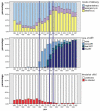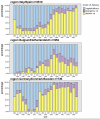Mode of delivery in HIV-infected pregnant women and prevention of mother-to-child transmission: changing practices in Western Europe
- PMID: 20059573
- PMCID: PMC3428890
- DOI: 10.1111/j.1468-1293.2009.00800.x
Mode of delivery in HIV-infected pregnant women and prevention of mother-to-child transmission: changing practices in Western Europe
Abstract
Objectives: The aim of the study was to examine temporal and geographical patterns of mode of delivery in the European Collaborative Study (ECS), identify factors associated with elective caesarean section (CS) delivery in the highly active antiretroviral therapy (HAART) era and explore associations between mode of delivery and mother-to-child transmission (MTCT).
Methods: The ECS is a cohort study in which HIV-infected pregnant women are enrolled and their infants prospectively followed. Data on 5238 mother-child pairs (MCPs) enrolled in Western European ECS sites between 1985 and 2007 were analysed.
Results: The elective CS rate increased from 16% in 1985-1993 to 67% in 1999-2001, declining to 51% by 2005-2007. In 2002-2004, 10% of infants were delivered vaginally, increasing to 34% by 2005-2007. During the HAART era, women in Belgium, the United Kingdom and the Netherlands were less likely to deliver by elective CS than those in Italy and Spain [adjusted odds ratio (AOR) 0.07; 95% confidence interval (CI) 0.04-0.12]. The MTCT rate in 2005-2007 was 1%. Among MCPs with maternal HIV RNA<400 HIV-1 RNA copies/mL (n=960), elective CS was associated with 80% decreased MTCT risk (AOR 0.20; 95% CI 0.05-0.65) adjusting for HAART and prematurity. Two infants born to 559 women with viral loads <50 copies/mL were infected, one of whom was delivered by elective CS (MTCT rate 0.4%; 95% CI 0.04-1.29).
Conclusions: Our findings suggest that elective CS prevents MTCT even at low maternal viral loads, but the study was insufficiently powered to enable a conclusion to be drawn as to whether this applies for viral loads <50 copies/mL. Diverging mode of delivery patterns in Europe reflect uncertainties regarding the risk-benefit balance of elective CS for women on successful HAART.
Figures


Similar articles
-
The mother-to-child HIV transmission epidemic in Europe: evolving in the East and established in the West.AIDS. 2006 Jun 26;20(10):1419-27. doi: 10.1097/01.aids.0000233576.33973.b3. AIDS. 2006. PMID: 16791017
-
Cesarean section for HIV-infected women in the combination antiretroviral therapies era, 2000-2010.Am J Obstet Gynecol. 2013 Oct;209(4):335.e1-335.e12. doi: 10.1016/j.ajog.2013.06.021. Epub 2013 Jun 18. Am J Obstet Gynecol. 2013. PMID: 23791563
-
Mother-to-child transmission of HIV infection in the era of highly active antiretroviral therapy.Clin Infect Dis. 2005 Feb 1;40(3):458-65. doi: 10.1086/427287. Epub 2005 Jan 7. Clin Infect Dis. 2005. PMID: 15668871
-
Current treatment strategies, complications and considerations for the use of HIV antiretroviral therapy during pregnancy.AIDS Rev. 2011 Oct-Dec;13(4):198-213. AIDS Rev. 2011. PMID: 21975356 Review.
-
Mother-to-child transmission of HIV-1 in the era prior to the availability of combination antiretroviral therapy: the role of drugs of abuse.Life Sci. 2011 May 23;88(21-22):922-5. doi: 10.1016/j.lfs.2011.03.006. Epub 2011 Mar 31. Life Sci. 2011. PMID: 21439978 Review.
Cited by
-
Modelling the impact of antiretroviral therapy on the epidemic of HIV.Curr HIV Res. 2011 Sep;9(6):367-82. doi: 10.2174/157016211798038533. Curr HIV Res. 2011. PMID: 21999772 Free PMC article. Review.
-
Motherhood and decision-making among women living with HIV in developed countries: a systematic review with qualitative research synthesis.Reprod Health. 2021 Jul 10;18(1):148. doi: 10.1186/s12978-021-01197-6. Reprod Health. 2021. PMID: 34246286 Free PMC article.
-
Testing for HIV Increases the Odds of Correct Fetal Ultrasound Result.Trop Med Infect Dis. 2022 Sep 13;7(9):242. doi: 10.3390/tropicalmed7090242. Trop Med Infect Dis. 2022. PMID: 36136653 Free PMC article.
-
Vertical Transmission of HIV-1 in the Metropolitan Area of Belo Horizonte, Brazil: 2006-2014.Rev Bras Ginecol Obstet. 2018 Feb;40(2):59-65. doi: 10.1055/s-0037-1613689. Epub 2017 Dec 18. Rev Bras Ginecol Obstet. 2018. PMID: 29253912 Free PMC article.
-
Estimating the effect of maternal viral load on perinatal and postnatal HIV transmission: a systematic review and meta-analysis.Lancet. 2025 Jul 26;406(10501):349-357. doi: 10.1016/S0140-6736(25)00765-2. Epub 2025 Jul 10. Lancet. 2025. PMID: 40652949 Free PMC article.
References
-
- Boer K, Nellen JF, Patel D, Timmermans S, Tempelman C, Wibaut M, et al. The AmRo study: pregnancy outcome in HIV-1-infected women under effective highly active antiretroviral therapy and a policy of vaginal delivery. BJOG. 2007;114(2):148–155. - PubMed
-
- European Collaborative Study The mother-to-child HIV transmission epidemic in Europe: evolving in the East and established in the West. AIDS. 2006;20(10):1419–1427. - PubMed
-
- Townsend CL, Cortina-Borja M, Peckham CS, de RA, Lyall H, Tookey PA. Low rates of mother-to-child transmission of HIV following effective pregnancy interventions in the United Kingdom and Ireland, 2000-2006. AIDS. 2008;22(8):973–981. - PubMed
-
- Warszawski J, Tubiana R, Le CJ, Blanche S, Teglas JP, Dollfus C, et al. Mother-to-child HIV transmission despite antiretroviral therapy in the ANRS French Perinatal Cohort. AIDS. 2008;22(2):289–299. - PubMed
-
- European Collaborative Study Caesarean section and risk of vertical transmission of HIV-1 infection. Lancet. 1994;343(8911):1464–1467. - PubMed
Publication types
MeSH terms
Substances
Grants and funding
LinkOut - more resources
Full Text Sources
Medical

